OUR BLOG
PRINCESS MILICA-THE FIRST FEMALE DIPLOMAT IN SERBIA
SERBIAN DIPLOMATS
Princess Milica was the ruler of Serbia, the wife of Serbian Prince Lazar, the first female diplomat of Serbia, and a medieval writer who was canonized as an Orthodox saint.
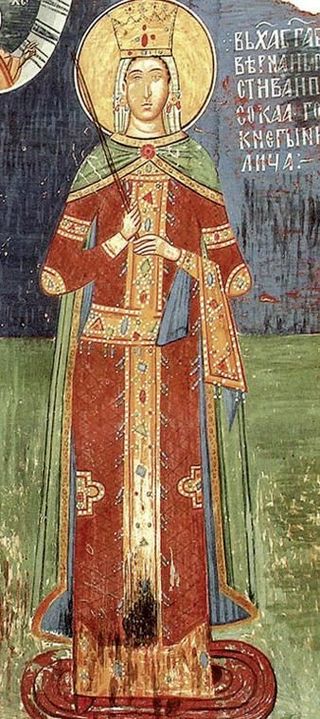 Princess Milica
Princess Milica
Milica Ḫrebeljanovic, better known as Princess Milica, was born around 1335. She was the great-great-granddaughter of Vukan Nemanjic, the eldest son of the great-perfect Stefan Nemanja, and the daughter of Prince Vratko, known in folk tradition as Jug Bogdan.
At her parents’ court, she received the basics of Christian life and literacy and was a frequent guest at the court of her cousin, Tsar Dušan, where, at the age of 18, she met her future husband, Lazar Ḫrebeljanovic, who was in the imperial service. By the way, Lazar was the son of a lower nobleman of Pribac, employed at the court of Emperor Dusan as a baker, state secretary, and great servant.
Although she was a princess of Nemanjic blood by origin and ranked far above her future husband in terms of lordly reputation, the emperor gave Milica to a young nobleman, because he loved him like a son. So in 1353, with his blessing, this love was crowned with a marriage in which Lazar and Milica had five daughters and three sons.
Very capable, Lazar quickly became independent as a ruler, and the princess and the prince decorated the court after the court of Emperor Dusan. Their home in Krusevac was a meeting place for many intelligent people of that time, and they also had a rich library, where translators and copyists gathered. The children were educated by local and foreign teachers, and an immeasurable contribution was made by the nun Jefimija, the widow of the despot Ugljesa Mrnjavcevic, who found refuge at the court of Hrebeljanovic.
During the lifetime of her husband, whom she was six years younger than, Milica was not politically engaged like Dušan’s wife Jelena.
However, after the battle in Kosovo in 1389, when Serbia lost its prince, a different life began for his heirs, and a fateful decision for the princess.
Thus, Princess Milica became the first woman in the history of Serbia who, in difficult state circumstances, took over the helm of Moravian Serbia in order, first of all, to ensure the inheritance of her minor son Stefan, who was only fifteen years old at the time.
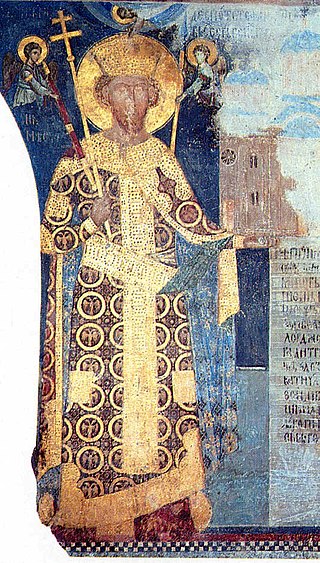 Despot Stefan Lazarevic, founding fresco from the church of the Manasija monastery
Despot Stefan Lazarevic, founding fresco from the church of the Manasija monastery
Although she was initially offered to move to Dubrovnik with her children, the beloved Serbian ruler remained in the devastated country, and in addition to taking care of her minor children, she dedicated herself to state affairs, where she proved to be a wise strategist and diplomat.
As the viceroy of the Principality of Serbia, she ruled from 1389 until the coming of age of her son Stefan in 1393, and the system of state administration during her reign was organized on the tradition and legal basis of the Code of Emperor Dusan.
History records that three months after the Battle of Kosovo, Milica saw that the Hungarian King Sigismund was preparing to attack Serbia, which is why she accepted an alliance with the Turks, until then, their biggest enemies. Serbia paid dearly for this alliance by receiving vassal obligations, but the price paid by the Serbian princess meant her great personal sacrifice. She married her youngest daughter, Olivera, to the Turkish Sultan Bayazit in 1390.
The first Serbian diplomatic mission led by women
Princess Milica’s first diplomatic success was achieved in the spring of 1391, a few months after Olivera’s daughter was handed over to the sultan’s harem in Edirne.
Stefano’s descriptions of the kind reception he received at the sultan’s court, bringing his sister, encouraged Princess Milica to go on a long journey herself the following spring.
Namely, Milica could not give her husband a decent burial because she was constantly searching for his body. After learning that the embalmed body is in the Church of the Ascension in Pristina, (although it is not known who and how it was taken from the battlefield and handed over to the monks for safekeeping), Milica begged two promises from Bayazit: that the Turks would not persecute the Serbian Orthodox Church and that he would allow preparing the transfer of her husband’s relics from Prishtina to the crypt of his endowment at the Ravanica monastery with the help of the church authorities. After Bayazit’s consent, Milica managed to organize a ceremonial transfer of the relics with the church and nobles, which was an important state step, because the enthronement of the saintly cult of Prince Lazar also meant consolidating the position of his son Stefan.
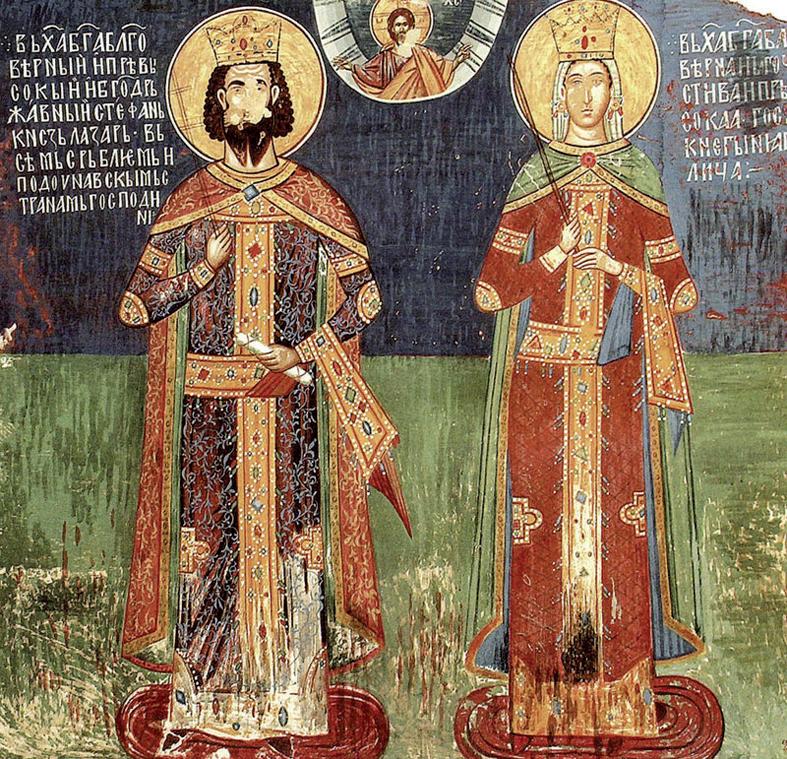 Prince Lazar and Princess Milica, Fresco, Ljubostinja monastery
Prince Lazar and Princess Milica, Fresco, Ljubostinja monastery
Princess Milica officially handed over power to Stefan, with the consent of the church and nobility, at the state assembly in early 1394. Knowing that he would need her experience and advice for at least some time, even though she had already become a monk in the Županjevac monastery under the name of Yevgenija, she continued to help him run the country, remaining an irreplaceable adviser to the young despot. She stood by him until death and found ways out of even the most difficult situations.
Young Stefan ruled at a time when the Lazarevic family had a special position at Bayazit’s court, which historians attribute to Olivera’s influence. But Stefan’s desire to get rid of the vassalage and get in touch with the Ugars angered Bayezit, so the security of the despot and the security of the state were severely shaken.
 Bayazit I
Bayazit I
It was recorded that the princess, already a nun, went to visit the angry Bayazit with the nun Yefimoja, which was the first Serbian diplomatic mission led by women. Under the pretext of wanting the consent of the sultan to transfer the relics of Saint Petka from Trnovo to Serbia, the nuns were saving the future of Serbia. Historians state that, despite everything, they were warmly received thanks to Princess Olivera.
The result of the visit was that the relics of the saint were transferred, but also that a meeting between Stefan and Bayazit was arranged, which followed shortly after the visit of the nuns, after which Stefan regained Bayazit’s favor.
The second visit of the nun Evgenia Sultan took place in 1402 when she begged him to reconcile her son Vuk with her brother. While she was alive, Princess Milica also managed to calm the passions between the warring brothers Vuk and Stefan who clashed over the Brankovic land in Kosovo. After Stefan criticized his brother for poorly leading the Serbian army into battle, Vuk joined Bayezid’s son Suleiman, one of the claimants to the Turkish throne, which caused a conflict between them and hit the princess hard. For this reason, she went to Suleiman to mediate in his reconciliation and brotherhood of Vuk to Serbia. However, the peace lasted while she was alive, and as soon as she passed away, Vuk became stronger, left the court, and went to Suleiman.
Ljubostinja Monastery
She spent the rest of her life in the silence of her endowment, the Ljubostinje monastery. There she saw off her lifelong friend, the nun Yefimia, after which she received the great sḫima, the highest degree of the monastic vow, as well as the new monastic name, Yephronisia. She experienced the marriage of despot Stefan in Belgrade, at his magnificent court, where almost all her children gathered.
In addition to being involved in politics, this famous Serbian woman is also known in the literature, where she left her mark by writing “Mother’s Prayer” and “Widowness to my Pupil”, an excerpt from “Praise to Prince Lazar” from 1403, which was burned in the National Library of Serbia after the German bombing in 1941.
Her name is associated with numerous benefactions to monasteries and churches. In 1392, she issued a charter to the Ḫilandar monastery, donating one church and several villages. Three years later, she donated to the Russian monastery of St. Panteleimon on Mount Athos, helped build the Sisojevac monastery near Ravanica, as well as reconstruction of the Dečani monastery after the Turks plundered it.
And yet, the crown of her endowment is certainly the Ljubostinja monastery near Trstenik, where she spent the last years of her life together with her friend Jefimija. 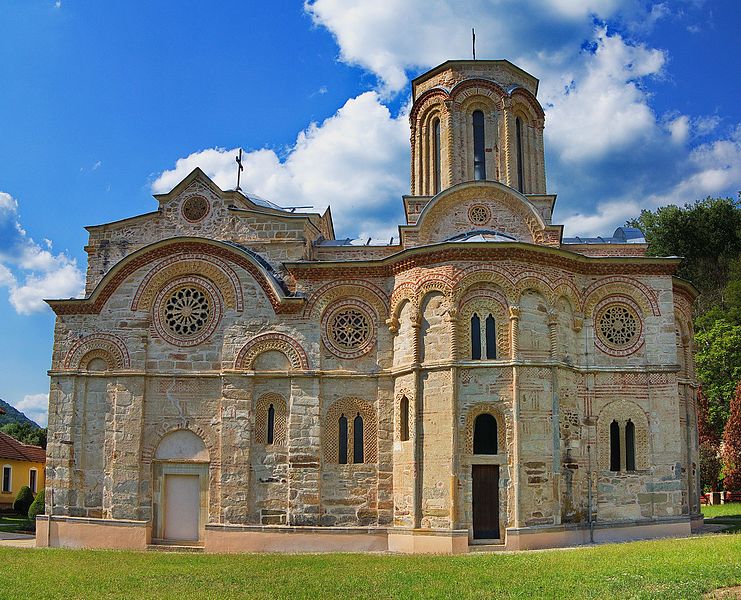
Ljubostinja Monastery Photo: Vladan Djordjevic, CC BY-SA 4.0 <https://creativecommons.org/licenses/by-sa/4.0>, via Wikimedia Commons
She died in the monastery on November 11, 1405., where she was buried, and her relics are still kept in the sarcophagus. The whole of Serbia and the monks of ḫilandar mourned her. She was canonized as a saint, so the Venerable Yefrosinija is celebrated on August 1 according to the new calendar, when her son, the despot Stefan, is also celebrated.
The love and respect that the people felt for her were sung in songs, and the writer of her life declares that “by her beauty and kindness she was not only a woman but also a wise Odysseus in many things. Who will pronounce all her deeds”?
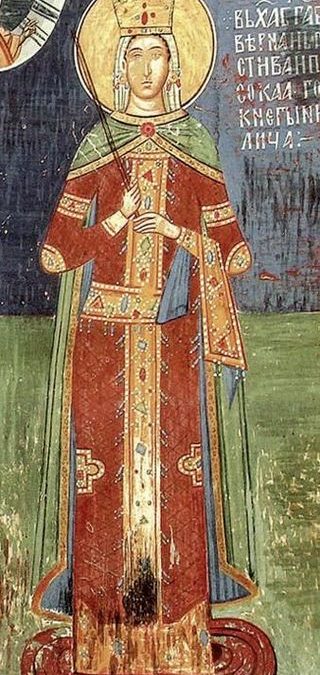







 2018
2018